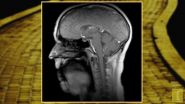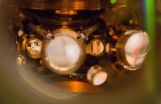(Press-News.org) In order to sing or speak, around one hundred different muscles in our chest, neck, jaw, tongue, and lips must work together to produce sound. Beckman researchers investigate how all these mechanisms effortlessly work together--and how they change over time.
"The fact that we can produce all sorts of sounds and we can sing is just amazing to me," said Aaron Johnson, affiliate faculty member in the Bioimaging Science and Technology Group at the Beckman Institute and assistant professor in speech and hearing science at Illinois. "Sounds are produced by the vibrations of just two little pieces of tissue. That's why I've devoted my whole life to studying it: I think it's just incredible."
The sound of the voice is created in the larynx, located in the neck. When we sing or speak, the vocal folds--the two small pieces of tissue--come together and, as air passes over them, they vibrate, which produces sound.
After 10 years of working as a professional singer in Chicago choruses, Johnson's passion for vocal performance stemmed into research to understand the voice and its neuromuscular system, with a particular interest in the aging voice.
"The neuromuscular system and larynx change and atrophy as we age, and this contributes to a lot of the deficits that we associate with the older voice, such as a weak, strained, or breathy voice," Johnson said. "I'm interested in understanding how these changes occur, and if interventions, like vocal training, can reverse these effects. In order to do this, I need to look at how the muscles of the larynx move in real time."
Thanks to the magnetic resonance imaging (MRI) capabilities in Beckman's Biomedical Imaging Center (BIC), Johnson can view dynamic images of vocal movement at 100 frames per second--a speed that is far more advanced than any other MRI technique in the world.
"Typically, MRI is able to acquire maybe 10 frames per second or so, but we are able to scan 100 frames per second, without sacrificing the quality of the images," said Brad Sutton, technical director of the BIC and associate professor in bioengineering at Illinois.
The researchers published their technique in the journal Magnetic Resonance in Medicine.
The dynamic imaging is especially useful in studying how rapidly the tongue is moving, along with other muscles in the head and neck used during speech and singing.
"In order to capture the articulation movements, 100 frames per second is necessary, and that is what makes this technique incredible," Johnson said.
With a recent K23 Career Development Award from the National Institutes of Health (NIH), Johnson is investigating whether group singing training with older adults in residential retirement communities will improve the structure of the larynx, giving the adults stronger, more powerful voices. This research relies on pre- and post-data of laryngeal movement collected with the MRI technique.
The basis for the technique was developed by electrical and computer engineering professor Zhi-Pei Liang's group at the Beckman Institute. Sutton and his team further developed and implemented the technique to make high-speed speech imaging possible.
"The technique excels at high spatial and temporal resolution of speech--it's both very detailed and very fast. Often you can have only one these in MR imaging," said Sutton. "We have designed a specialized acquisition method that gathers the necessary data for both space and time in two parts and then combines them to achieve high-quality, high-spatial resolution, and high-speed imaging."
To combine the dynamic imaging with the audio, the researchers use a noise-cancelling fiber-optic microphone to pull out the voice, and then align the audio track with the imaging.
"We have a very dynamic community at the Beckman Institute and Illinois working on this, from engineers to linguists, and we're able to measure things with MRI in ways we couldn't have just a couple of years ago," Sutton said. "But what makes it worthwhile is having people like Aaron who ask the scientific questions that drive our research forward."
INFORMATION:
COLUMBUS, Ohio - It's estimated that six out of 1,000 children worldwide are affected by autism spectrum disorder (ASD), and 50 percent demonstrate serious and disruptive behavior, including tantrums, aggression, self-injury and noncompliance.
For children with ASD, serious disruptive behavior interrupts daily functioning and social skills development, limits their ability to benefit from education and speech therapy, can increase social isolation and intensify caregiver stress.
Luc Lecavalier and his team of researchers from The Ohio State University Wexner Medical ...
In a small study that included seven children and teens with Wiskott-Aldrich syndrome, a rare immunodeficiency disorder, use of gene therapy resulted in clinical improvement in infectious complications, severe eczema, and symptoms of autoimmunity, according to a study in the April 21 issue of JAMA, a theme issue on child health.
Wiskott-Aldrich syndrome (WAS) is caused by loss-of-function mutations in the WAS gene. The condition is characterized by thrombocytopenia (low platelet count), eczema, and recurring infections. In the absence of definitive treatment, patients ...
In a study that included approximately 95,000 children with older siblings, receipt of the measles-mumps-rubella (MMR) vaccine was not associated with an increased risk of autism spectrum disorders (ASD), regardless of whether older siblings had ASD, findings that indicate no harmful association between receipt of MMR vaccine and ASD even among children already at higher risk for ASD, according to a study in the April 21 issue of JAMA, a theme issue on child health.
Although a substantial body of research over the last 15 years has found no link between the MMR vaccine ...
A 24 week parent training program, which provided specific techniques to manage disruptive behaviors of children with autism spectrum disorder, resulted in a greater reduction in disruptive and noncompliant behavior compared to parent education, according to a study in the April 21 issue of JAMA, a theme issue on child health.
Autism spectrum disorder (ASD) affects an estimated 6 per 1,000 children worldwide and is a major public health challenge. As many as 50 percent of children with ASD exhibit behavioral problems, including tantrums, noncompliance, aggression, and ...
In a pilot study that included children at high risk for type 1 diabetes, daily high-dose oral insulin, compared with placebo, resulted in an immune response to insulin without hypoglycemia, findings that support the need for a phase 3 trial to determine whether oral insulin can prevent islet autoimmunity and diabetes in high-risk children, according to a study in the April 21 issue of JAMA, a theme issue on child health.
A few specific proteins are often the trigger for immune responses that cause autoimmune diseases. This has led to the experimental use of antigenspecific ...
The incidence of a potentially life-threatening complication of diabetes, diabetic ketoacidosis, in youth in Colorado at the time of diagnosis of type 1 diabetes increased by 55 percent between 1998 and 2012, suggesting a growing number of youth may experience delays in diagnosis and treatment, according to a study in the April 21 issue of JAMA, a theme issue on child health.
Diabetic ketoacidosis (DKA) at the time of type 1 diabetes (T1D) diagnosis has detrimental long-term effects and is characterized by dangerously high blood sugar and the presence of substances in ...
A multi-site study sponsored by the National Institute of Mental Health (NIMH) finds young children with autism spectrum disorder and serious behavioral problems respond positively to a 24-week structured parent training. The benefits of parent training endured for up to six months post intervention.
Published in the April 21 issue of the Journal of the American Medical Association the study found parent training was more effective in reducing disruptive and aggressive behavior than 24 weeks of parent education. Parent training provided parents with specific strategies ...
Researchers from the University of Tokyo have revamped an old e-paper concept to make an inexpensive handwriting-enabled e-paper well suited to large displays like whiteboards. They describe the e-paper in the Journal of Applied Physics, from AIP Publishing.
Traditional ink and paper is convenient for both reading and writing. In e-paper development the writing feature has generally lagged behind. Handwriting-enabled displays mainly show up in the inexpensive, but feature-limited realm of children's toys, and in the high-end realm of touch-screen e-readers and smart ...
French teams from CIC Biothérapie (AP-HP/Inserm), from pediatric hematology department of Necker Hospital for Children (AP-HP), led by Marina Cavazzana, Salima Hacein Bey Albina and Alain Fischer and from Genethon led by Anne Galy (Genethon/Inserm UMR-S951), and English teams from UCL Institute of Child Health and Great Ormond Street Hospital in London led by Adrian Thrasher and Bobby Gaspar demonstrated the efficacy of gene therapy treatment for Wiskott-Aldrich Syndrome (WAS). Six children that were treated and followed for at least 9 months had their immune system ...
BOULDER, Colo. -- In another advance at the far
frontiers of timekeeping by National Institute of
Standards and Technology (NIST) researchers, the
latest modification of a record-setting strontium atomic
clock has achieved precision and stability levels that
now mean the clock would neither gain nor lose one
second in some 15 billion years*--roughly the age of
the universe.
Precision timekeeping has broad potential
impacts on advanced communications, positioning technologies (such as GPS) and many
other technologies. Besides keeping future technologies on schedule, ...



